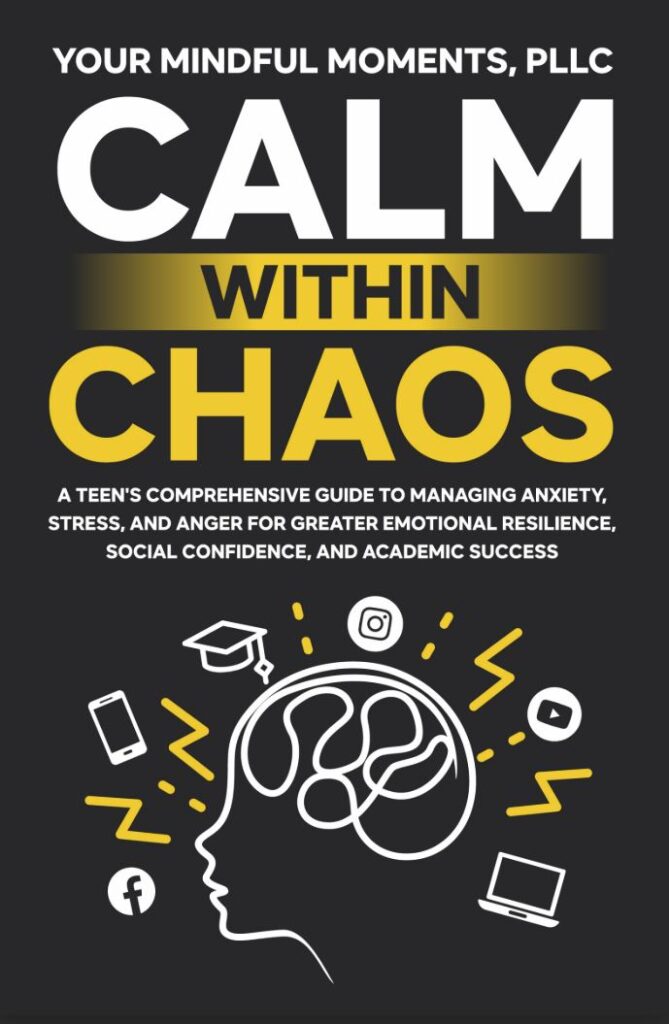Rating: ⭐⭐⭐⭐✭ (4.1/5)
Publication date: June 1, 2025
Intended audience: Teens, parents, grandparents, and caretakers responsible for teens
Introduction: A therapist-built roadmap for real teen life
Teenagers today navigate academics, friendships, identity, and a 24/7 digital world—often with stress levels that adults underestimate. Calm Within Chaos meets that reality head-on. Framed as a step-by-step program, it blends compassionate coaching with clinically grounded tools to build emotional regulation, social confidence, and academic focus. From the dedication and author’s note onward, the tone is validating to both teens and caregivers: you’re not alone; regulation is a learnable “superpower,” and this book is built to practice it, not just read about it.
What makes it especially useful is its structure: each chapter introduces core concepts, then turns them into “Teen Inner Peace Challenges” and End-of-Chapter Reflections, creating a repeatable routine teens can actually follow.
What the book teaches (and how it lands with teens & families)
1) Understanding emotions before they take the wheel
Early chapters show why emotions spike in adolescence and how they drive behavior. Teens learn the name → trigger → body cue → thought chain so they can intervene earlier. The Day-by-Day challenges are clear and practical: precisely name feelings, log triggers, scan body signals (tense shoulders, racing heart), and separate thoughts from emotions—a sequence that lays the groundwork for regulation.
Why this matters: specificity beats vagueness. Accurately labeling “resentful” vs “sad” leads to better coping choices—a theme reinforced by the contents’ emphasis on emotional awareness and vocabulary with a built-in practice cadence (Challenge → Reflection).
2) Stress management teens will actually try
Instead of generic advice, the stress chapter offers concrete techniques: time-boxing, sleep and movement basics, mental resets (breathing, grounding), and simple systems teens can maintain when school pressure peaks. Its placement and scaffolding (Skills → Challenge → Reflection) make it easy to implement during test weeks or social flare-ups.
3) Anger reframed as information, not shame
Anger isn’t demonized; it’s contextualized—as a signal with potential upsides when channeled well. Teens map triggers/responses, learn cooling sequences, and practice timing conversations for success. The chapter explicitly addresses anger’s role in relationships and mental health, then pivots to constructive use—boundary setting, direct but respectful communication.
4) Resilience is trained, not “born with”
A standout strength is the book’s accessible neuroscience: resilience grows with reps, not luck. Short habits—mindfulness, self-awareness, and deliberate response selection—compound into mental toughness. The section titles make the science approachable and action-oriented (Mindfulness, Regulation, Self-awareness), again closing with Challenge/Reflection to cement skill.
5) Friendship skills & conflict repair
Teens learn empathy statements, “I” messages, and repair rituals after emotional spikes. A key bit is training the mind to separate facts from stories during conflict—reducing mind-reading and escalation. This chapter is practical for school and home dynamics alike.
6) Emotions → attention → academics
The academics section connects calm focus with performance. It integrates goal-setting and affirmations with regulation tools, recognizing that attention is emotional before it’s cognitive. Again: teach → practice → reflect, so these skills stick when the semester gets tough.
7) Self-talk, esteem, and believable growth
Instead of “toxic positivity,” teens are taught thought-labeling (catch → check → change) and values-aligned micro-actions. A guided affirmation exercise makes confidence earned and embodied, not faked.
8) Digital mindfulness that respects reality
The digital chapter avoids “just use your phone less.” It addresses how social media impacts mood and gives boundary templates (tech-free zones, breaks, wind-down windows). Quizzes and answers reinforce that mindfulness helps you “pause, focus on the moment, and step back from the constant noise of technology”—a direct, teen-friendly formulation.
9) Emotional intelligence & future readiness
The closing section ties EQ to relationships and school success, clarifying the components of EQ and how to practice them under stress. The message is consistent: calm is a skill; practice makes it reliable when it counts.
Why this works for both teens and caregivers
- Two-audience design: From the opening pages, the author speaks directly to teens and thanks parents/caregivers, asking them to shape a home environment that encourages growth—reframing the family as a coaching team for regulation.
- Practice-first format: Every chapter ends with a Challenge and Reflection, turning ideas into routines (perfect for schools, counseling groups, or home plans).
- Clinically grounded, compassionate tone: The author’s note sets a validating, strength-based stance and frames regulation as a lifelong skill teens can build with patience and self-kindness.
About the Author: Paul DeRenzo, LMHC — Founder, Your Mindful Moments, PLLC
Paul DeRenzo is a licensed therapist and the founder behind Your Mindful Moments, PLLC. With 10+ years helping teens and adults navigate anxiety, anger, stress, and relationship challenges, he blends mindfulness and cognitive-behavioral strategies to teach emotional regulation as a lifelong skill. His practice and writing aim to equip families with practical tools, repeatable habits, and a shared language for calmer communication and resilient living.
Follow & explore resources:
- Instagram: @your.mindful.moments
- Facebook: Your Mindful Moments
- TikTok: @ur.mindful.moments
- Book / Link: Calm Within Chaos
This is a full program, not a skim. If you’re hoping to “change the world in 200 pages,” be ready for a thorough, exercise-heavy journey. The density is a feature—each practice builds competence—but time-pressed readers may find the depth a little long in parts. (We see it as a worthy tradeoff for real behavior change.)
Who should read this?
- Teens who want tools they can try today for anxiety, stress, anger, friendships, and digital balance.
- Parents, grandparents, and caretakers seeking a shared playbook and calmer, more collaborative conversations at home.
- Schools, counselors, youth programs needing a structured curriculum with practice and reflection built-in.
Overall Rating & Recommendation — ⭐⭐⭐⭐✭ (4.1/5)
Calm Within Chaos turns emotional regulation into a doable routine. It’s empathetic without being vague, structured without being clinical, and practical without losing heart. If your goal is real change—in the classroom, at home, or within yourself—this belongs in your weekly rhythm.
👉 Get the book: Calm Within Chaos
👉 Follow for tips & videos: Instagram · Facebook · TikTok
Closing line
“In the end, Calm Within Chaos is less a book and more a toolkit—helping teens turn big feelings into clearer choices, and families turn hard moments into habits that last.”







